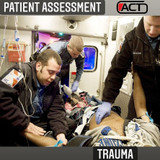Patient Assesment/Trauma

Trauma Assessment
Please keep in mind this is for Primary responders and hospital staff. Some of the methods you learn for TECC/TCCC don’t always apply in the same order. This a issue many medics have transitioning into TECC/TCCC Care as this is what they are taught from day one and it’s hard to adjust this mindset at times.
BSI scene safe - in the third slide what we meant to say was if you are safe then continue with your assessment and treatment. We are not advocating you to work on an unsafe scene.
Trauma assessments are a basic skill, you do not need to be a paramedic to become proficient at this skill. The more it’s completed the more proficient you will become.
It is rapid. This allows you to identify and treat life threats and begin to stabilize the patient for transport. Some would argue you need to expose the patient at this time but I prefer to get them to the back of an ambulance for their dignity and only expose what’s necessary. Use your judgement.
Appropriate questioning of the patient can go a long way, learn what questions to ask and ask direct questions that are not open ended. The patient can be your best resource. If they can’t remember or can’t talk then you know your patient has a significant injury and may have head trauma. Error on the side of caution with this.
At the end of the day, you will not be performing surgery in the back of your ambulance, check the patient and reassess frequently for changes but a solid assessment will make it that much easier in the ED For the patient to get the care they need.
What’re some tips and tricks you use for your trauma or patient assessments? Share below!
